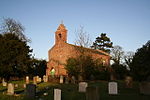Hubberts Bridge

Hubberts Bridge is a village in the borough of Boston, Lincolnshire, England. It is situated within the civil parish of Frampton, and approximately 3 miles (5 km) west from Boston. The village name derives from the bridge crossing the South Forty-Foot Drain. Originally it was a wooden structure, thought to have been owned by Robert Hubbert, born on the 2 March in Lincolnshire and died in 1850 in Boston, Lincolnshire. A new wooden bridge was erected about 1850, but was replaced again by a brick structure in 1888 by the county justices for the Parts of Holland from designs of John Kingston, county surveyor.The village is served by Hubberts Bridge railway station, and has a local public house, the Wheatsheaf Inn, and a community centre.
Excerpt from the Wikipedia article Hubberts Bridge (License: CC BY-SA 3.0, Authors, Images).Hubberts Bridge
Station Road,
Geographical coordinates (GPS) Address Nearby Places Show on map
Geographical coordinates (GPS)
| Latitude | Longitude |
|---|---|
| N 52.973375 ° | E -0.11321 ° |
Address
Station Road
Station Road
PE20 3QR , Frampton CP
England, United Kingdom
Open on Google Maps









